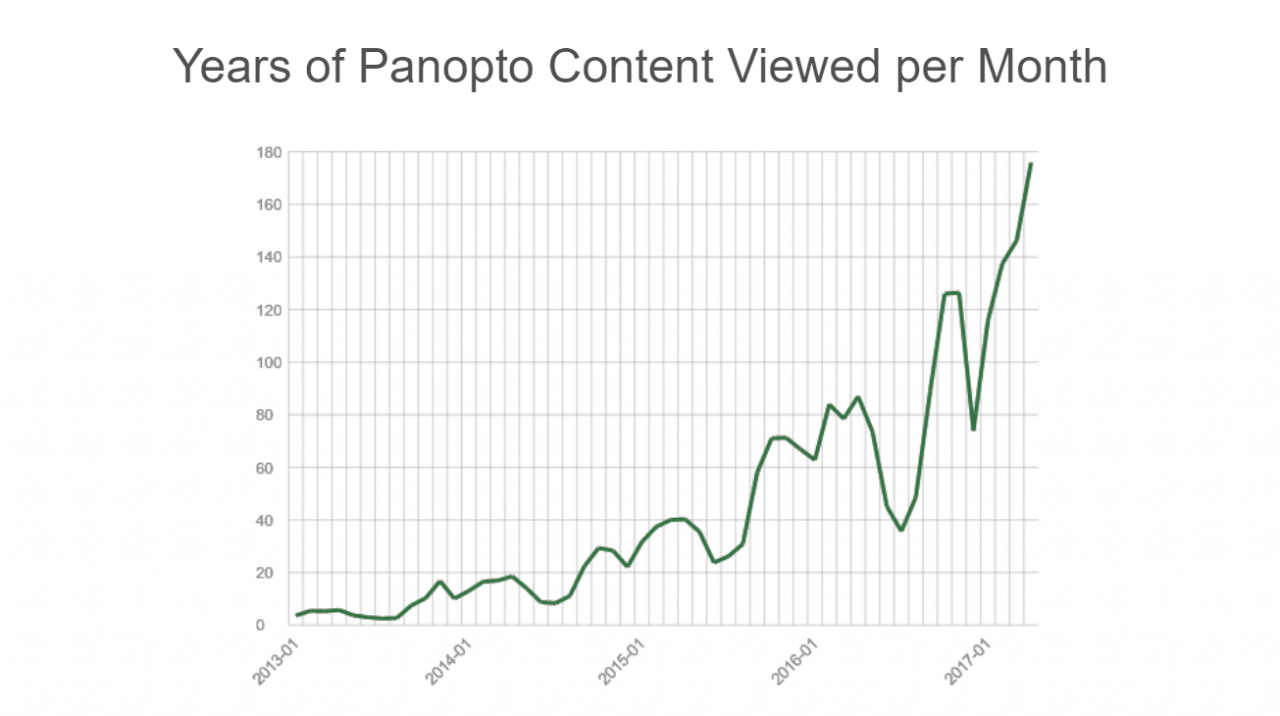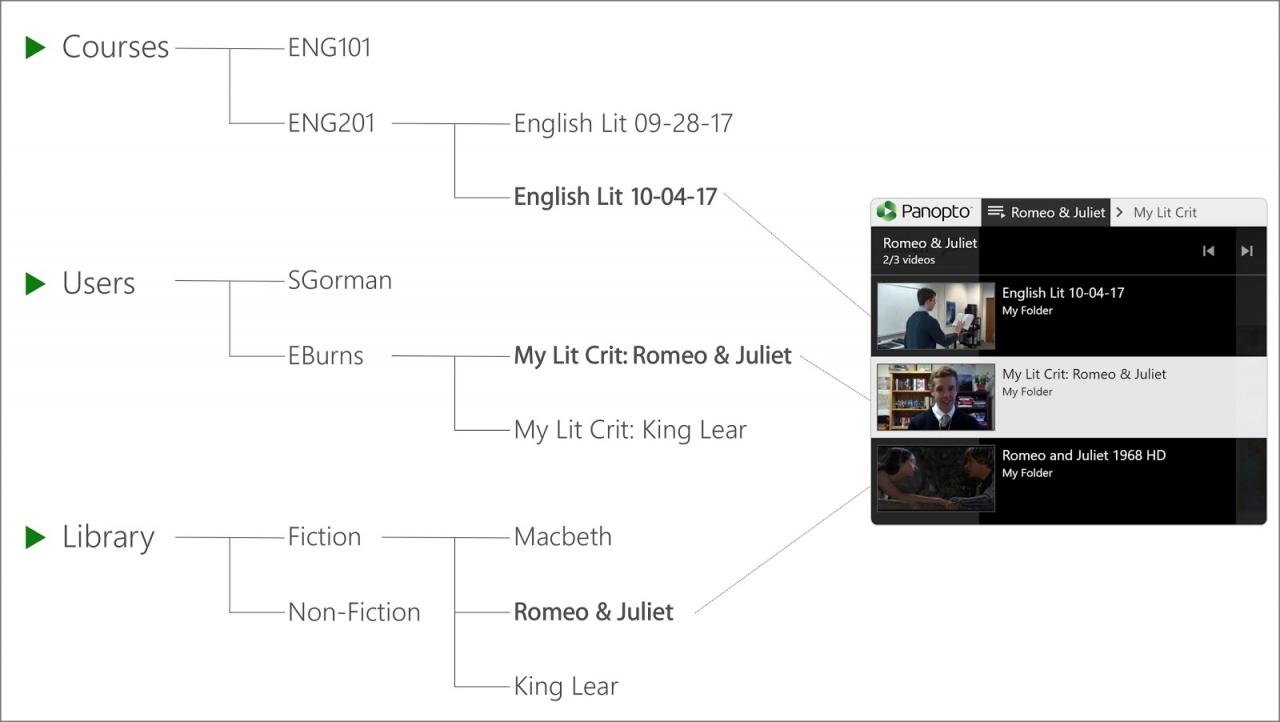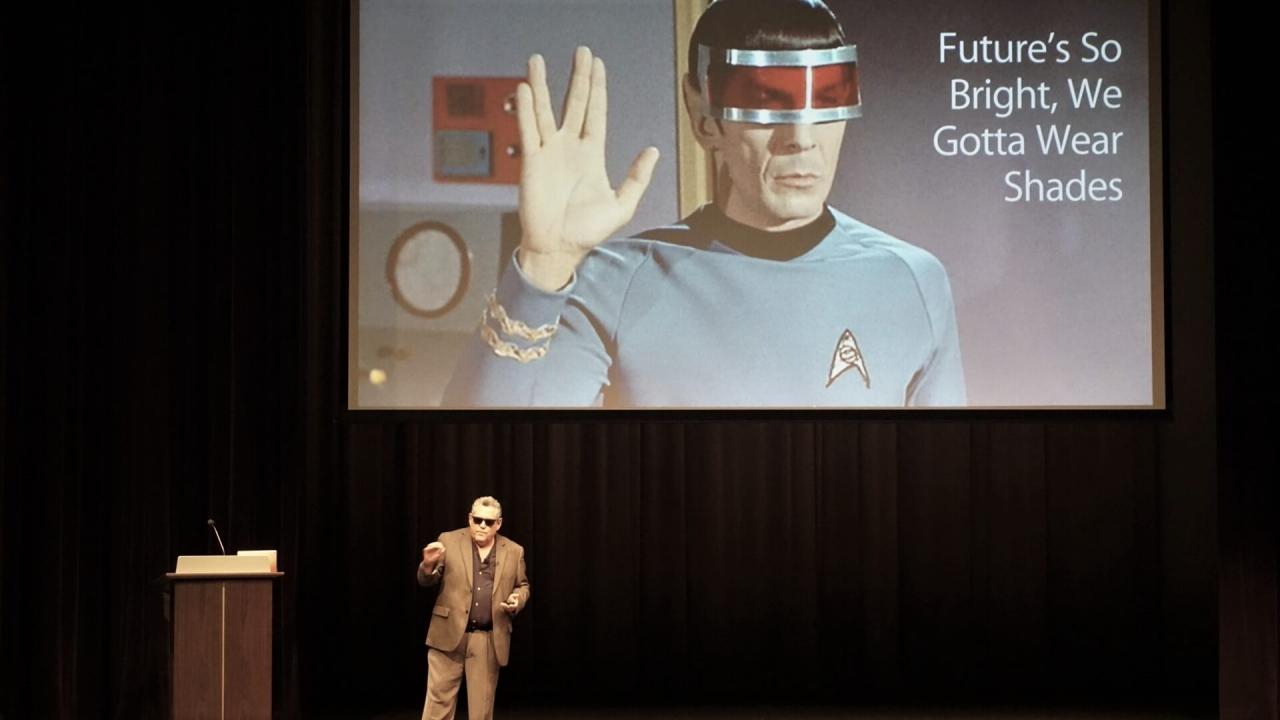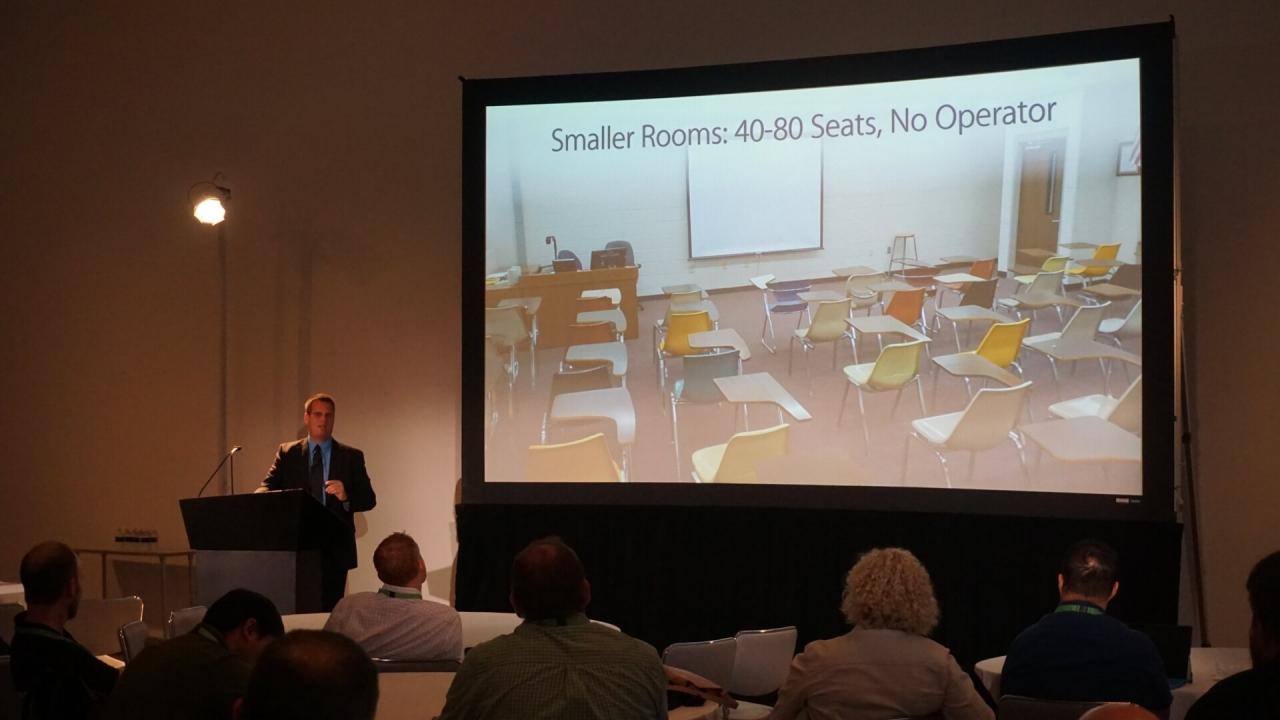- Communications
Highlights from Panopto’s First North American User Conference
On October 4, learning technologists, educators, and trainers from across the U.S. and Canada came together in Chicago for Panopto’s first North American User Conference. It was a chance for Panopto users to network with each other, and an opportunity for us to learn how we can better support applications for video in universities and businesses.
As part of the event, we also celebrated our 10-year anniversary with many of our customers who have been part of our journey over the last decade.
Ten Years of Panopto
The Next Ten Years of Video
In keynote presentations from our co-founder and CEO, Eric Burns, and Wainhouse Research Senior Analyst and Partner, Alan Greenberg, we got a look ahead to the future of video-based learning and communications.
Looking Back at the “Silent Revolution” and Ahead to the “Universal Library”
Eric Burns began with a look back at two recent, disruptive forces in online learning — MOOCs and online program management (OPM). Both have enjoyed media hype cycles fueled by bold predictions, like Sebastian Thrun’s declaration of a future with just 10 traditional universities, and big announcements like Purdue’s recent acquisition of Kaplan.
Yet, amid all the press coverage, data that suggests that lecture capture and the flipped classroom pedagogy have had a far greater impact on higher education — a “silent revolution” that has largely slipped under the media radar.
The use of video has surged on college campuses, not as a replacement for traditional face-to-face learning, but as a critical tool for supporting instruction and improving student outcomes.

Ubiquitous, accessible video has also helped institutions overcome practical challenges — extending education to more students without requiring new infrastructure, enabling instructors to use classroom time for active learning, and better serving the needs of students with disabilities.
In the years ahead, Burns predicts that institutional video archives will evolve to comprise three types of media:
- Lecture recordings that are bound to courses
- Videos uploaded by faculty, staff, and students into personal repositories
- 3rd-party video, including copyrighted work licensed under the FAIR USE Act
Today, most institutions treat these as three disparate video use cases. Burns sees them as part of the same system – a “universal library” of institutional knowledge and media assets.

With a universal library, instructors can make unencumbered use of video as part of their pedagogy, incorporating recorded lectures, videos they create, and videos curated from the university collection. And through the use of playlists, these videos can be referenced and reused in sequential lesson plans for students in both residential and online programs.

Ultimately, these living libraries of institutional knowledge will provide the technological foundation for what MOOCs and OPM initially set out to achieve — reproducing the in-class experience online so that anyone can access high-quality education.
Video Everywhere
Senior Analyst & Partner at Wainhouse Research, Alan Greenberg, followed Burns and confirmed the massive popularity of video — nearly 74% of online traffic today is watching video content.
Greenberg presented data that highlighted the positive impact on student learning outcomes that stem from the adoption of lecture capture in higher education, and posited that video learning trends in higher ed, combined with the overarching trend of increased video consumption everywhere, is also driving greater usage of video content in the workplace than ever before.
Similar to the flipped classroom concept that has skyrocketed to popularity in classrooms, businesses like Red Robin, Cineplex, and even the Denver Broncos football franchise, now use employee-generated video content for informal social learning — a concept Greenberg calls “The Flipped Content Creator.”
But Greenberg’s research shows we have not reached “peak video” — there is still room to grow.

Greenberg predicts that the growth of video learning in the years ahead will be fueled by the adoption of several key technologies, including:
- Video content management systems that include advanced video search capabilities
- Multi-camera video streaming technologies that improve the virtual training experience
- Augmented reality (AR), virtual reality (VR), and artificial intelligence (AI)
Ultimately, Greenberg believes — and we agree — that video learning has a bright future, and we have yet to fully experience the benefits of evolving video technologies.

Panopto Power Users Share How They Leverage Video On Campus
In afternoon breakout sessions, our power users took the stage to share the novel ways they’re using video to improve student learning experiences. Presentations showcased how schools leverage Panopto to solve asset management challenges at scale, improve accessibility, live stream events, and employ the flipped classroom pedagogy.
Managing Video at Scale
Greg Gromak, Senior Multimedia Specialist at the University of Central Florida In one of our first breakout sessions, Greg Gromak discussed how the University of Central Florida (UCF) selected and standardized a single lecture capture system throughout campus, which would ultimately allow more students to participate in courses remotely.
In one of our first breakout sessions, Greg Gromak discussed how the University of Central Florida (UCF) selected and standardized a single lecture capture system throughout campus, which would ultimately allow more students to participate in courses remotely.
The selection team at UCF performed a technology needs assessment to determine the key features the school needed from its new lecture capture system and ran pilots with a shortlist of vendors in different classroom settings. Faculty and other stakeholders tested each system and provided feedback.
Gromak went into great detail about the broad range of technical considerations and special use cases that the university needed its lecture capture system to support, from management and governance to capturing multiple video streams. Its decision to use Panopto was largely due to the flexibility, scalability, and ease of use of our video platform.
Looking back, Gromak gave recommendations for schools looking to scale up lecture capture on their campuses:
- Invite everyone to participate in the pilots
- Make a data-driven decision
- Ensure your system is scalable
- Do not treat user training as an option
Flipping the Classroom
Frank Fedel, Associate Professor of Orthotics and Prosthetics at Eastern Michigan University
Frank Fedel showed extensive examples of how he uses Panopto’s video platform to flip the classroom, and how this pedagogy is preparing his medical students for real-world scenarios.
The following are a few of the ways Fedel is using Panopto to flip his classroom and to engage students more in active learning activities:
- Recording lecture content that can be viewed outside of class
- Showing physical demonstrations from multiple viewpoints
- Sharing detailed instructional videos to better prepare students for labs
- Clicker quizzes that help students retain key concepts
- Recording student videos to demonstrate competency and proficiency
- Other video-based learning modules
Looking to the future, Fedel is eyeing other technologies that can help prepare his medical students such as 3D printing, augmented reality (AR), virtual reality (VR), and 360° video.
Making Learning More Accessible
Panel Discussion

Our first panel discussion of the day featured Jon Degroot, Director of Flexible Learning at Northcentral Technical College, Kirk Batterson, Instructional Technology Consultant at University of Iowa, and Chris Soran, eLearning Director at Tacoma Community College. The topic: how technology helps make education accessible to students with disabilities.
When people think about accessibility with regard to lecture videos, they often think of captioning. Video captions need to be accurate, styling needs to be flexible (colors, fonts, etc.), and the placement of captions is extremely important.
But educators also need to make sure that their video platform serves students with other types of disabilities. Video platforms should offer screen reader support to help visually impaired students, as well as keyboard navigation, which can also make video content useful for visually impaired students or those with motor disabilities.
Educational technologies support accessibility and help faculty by ensuring that their online materials serve the needs of all their students.
Live Streaming Events
Brian Beck, Lead Audio Visual Technician at Kettering University

Brian Beck of Kettering University shared his experiences live webcasting events like graduation with Panopto. Beck walked through his entire process for preparing to live stream an event, from partnering with IT to procuring technical equipment to testing repeatedly.
And while preparing to broadcast a live event on campus requires a lot of meticulous planning and coordination, Beck noted that broadcasting and live streaming the event on the day-of is actually remarkably easy with Panopto. Beck noted, “If you can record a session, you can live stream.”
Beck also discussed the benefits of one of Panopto’s unique features: distributed recording. With distributed recording, Beck’s team can sync multiple video streams in the cloud, even during a live broadcast. As a result, it’s much easier to set up a live recording with multiple camera angles or media streams, since all the recording devices don’t have to be connected in one closed system.
Beck also shared key takeaways from his experience with live streaming, including the importance of audio quality over video quality and the reliability of hard-wiring over wifi streaming.
The Value of Recording Student Presentations
Rob Peregoodoff, Director of Learning Services at University of British Columbia’s Sauder School of Business 
In 2011, Rob Peregoodoff was challenged by administrators in University of British Columbia’s (UBC) Sauder School of Business to devise a technology system that could scale the school’s ability to record student presentations.
The business school had identified a need to help students develop better presentation skills before going out into the workforce. From interview preparation to business strategy pitches, UBC was looking for a way to capture hundreds of student presentations that could easily be reviewed by professors who would then provide feedback to students.
UBC eventually deployed Panopto to laptops at video recording stations that could record student presentations at scale — capturing 400 student presentations in 48 hours. And with this system, professors could also return feedback on the recordings to the students within 24 hours.
Recording themselves and receiving feedback from their professors helped UBC business students develop and refine their professional presentation skills and many applauded the experience.

Video’s Impact On The Student Experience
Student Panel Discussion

In our second panel discussion, graduate students took the stage to give their perspectives on how video has shaped their learning experiences. Sitting on the student panel was Jason Pacynski, Master’s in Finance 2018 at Notre Dame, Currently VP of IT Finance at Edelman, Mackenzie Gilmore, BSN, Masters Candidate, Orthotics and Prosthetics at Eastern Michigan, and Lamar Allen, The John Marshall School of Law, Juris Doctor Candidate, 2020.
Similar to our earlier accessibility panel, students told personal stories about their experiences as busy grad students that shared consistent themes. With responsibilities outside of the classroom ranging from jobs to kids, access to recordings of class lectures and content makes it easier for them to squeeze in meaningful learning when they can, wherever they are.
And video, for each of them, has become the go-to format for learning anything new — whether it’s how to fix an appliance at home or to learn something that will help advance a career doing what they love.
Each student had the same resounding plea: Please record all of your lectures!
Panopto Roadmap
Not only did user conference attendees get a sneak peek of our product roadmap, but they also got the floor to ask VP of Product Engineering, Tim Sullivan, about the features they are most looking forward to and the capabilities they hope to see in Panopto.
Judging from the applause in the room, it sounded like users were most excited about forthcoming information architecture changes within Panopto that will make it easier to mirror LMS structures, create video channels, and re-organize video assets. Sullivan covered a long list of features we’re working on, so check the hashtag on Twitter for others that might have leaked out: #PanoptoCon. Or ask your Panopto Customer Service Advocate!
Coming soon to @Panopto: student sign-on, mobile quizzing, editor enhancements, gradebook integrations, at-a-glance analytics #PanoptoCon pic.twitter.com/Kw7Gel1fvG
— Panopto (@Panopto) October 4, 2017
We’ll Be Back Next Year!
If you didn’t get to join us at our first North American User Conference, we hope you can join us next year. And for those of you who are not yet Panopto users, there’s still plenty of time to become one. You can start by seeing what all the hype is about by requesting a free trial.





